
Understanding the Importance of Correct Seating Posture
As many people have transitioned to remote work during lockdown, there's a noticeable shift in our daily behaviors, particularly how long we sit. Poor posture can lead to discomfort or chronic pain, necessitating a focus on seating habits. By understanding and implementing correct seating posture, we can foster a healthier work-from-home experience.
The Foundation of Good Posture: Pelvic Positioning
A common mistake is to concentrate solely on shoulder alignment and back support. However, the secret lies deeper. Your seated posture hinges on the positioning of your pelvis. Imagine a dinosaur tail extending from your tailbone, encouraging your pelvis to sit back and down. This visualization can greatly improve your spinal alignment and overall posture.
Practical Steps to Improve Your Seating Posture
Make small adjustments to create a fitting workspace at home. Begin by placing both feet firmly on the ground and ensuring your back is adequately supported. It's also crucial to keep your shoulders back and maintain an open chest to alleviate strain. Raise your eye line to keep your chin parallel to the ground when using devices. These minor adjustments can pave the way for a long-term reduction in discomfort and improvement in your overall well-being.
Long-term Benefits of Good Posture
Maintaining correct seating posture not only protects your spine but enhances blood flow to vital organs and fosters better breathing. As you engage in different tasks, notice how your pelvis position can improve your comfort throughout the day. Adopting good habits today translates to better health in the future.
Explore Holistic Osteopathic Care
If you're dealing with discomfort that stems from poor posture or you want personalized guidance on improving your well-being, consider visiting a holistic osteopathy clinic. They can provide therapies for chronic pain management, prenatal care, and other services tailored to family needs. Engaging with qualified osteopaths can help you unlock pain relief strategies beyond traditional methods.
Taking charge of your seating posture is a simple yet effective way to enhance your quality of life. Small changes lead to significant outcomes — and that should be your motivation to start today!
 Add Row
Add Row  Add
Add 




Write A Comment